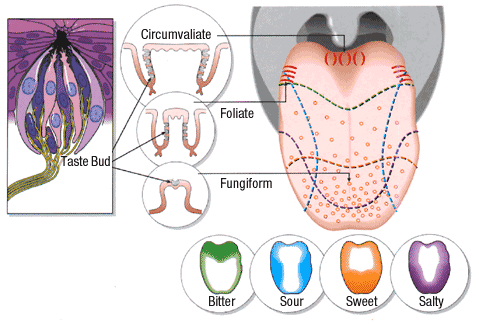The assessment of wine taste is the most pleasant and long awaited part, but also the most difficult. Wine has many flavours due to a variety of factors such as the grape variety or varieties, the technology of making and maturing... and many more. It is important to know that the flavours are produced in a different way and different parts of your tongue, the palate and nose again sense them in a different manner as well. When drinking the first sip, the volatile substances in wine evaporate and enter the nasal cavity. Therefore, we speak not only about taste but also about taste flavours.
Curious facts: Even Aristotle classified the four basic tastes: sweet, salty, sour and bitter. And modern science has established with certainty the position of the various taste receptors on the tongue.

It is really funny to watch professional tasters. They puff, drink noisily and make sounds that every well-mannered person avoids. On top of that, they spit out the wine. If you do not know or cannot guess, they do so not to assess its qualitative or quantitative characteristics but because of its alcohol content since they have to try several dozens, even hundreds, of wines. And it is not prestigious to walk between the tables tottering. If you happen to find yourself at a wine tasting event and if you know your limits, then do not hesitate to taste wine. Ultimately, it is made for this purpose and the full pleasure of it is experienced in this way. Here is a trick: you can eat some bread and let it divide the tastes of different wines.
If you have gathered with friends to try several bottles of different wines, it is not necessary to use tricks as drinking the wine is a must.
Ultimately, what makes a good wine?
Many factors, as already described. Firstly, it is the area where the vineyards are located. It is no accident that wines bear the name of the region where they are made. A classic example is Champagne, the name of which comes from the French province of Champagne.
There is a criterion called "complexity" that combines all of the above ways of becoming familiar with wine, taste and flavour being the main factors. We could call complex the wine in which we find more than a few "storylines", both in the nose and in terms of its taste and flavours. Everything is so intertwined that it leaves a feeling of harmony and perfection of the drink. Such wine reveals itself gradually: from the initial attack of taste through the development of the various flavours that change over time after sipping, and even after each sip. Such well-aged wines are soft and leave a distinctive aftertaste. They are said to be "long wines."
Another criterion is the "typicality" of a wine. Ultimately, if all wines were alike, it would not matter where they were made, with what technology, how, and how long, they matured. We could call a wine typical of the variety from which it was made, if it has its basic characteristics.
You have already guessed that the criteria for assessing a wine are many and often subjective, based on the experience, taste receptors and prestige of those who assess it. The qualities of a variety that are accepted as typical are the result of consensus among a group of people whose opinion is taken as a reference. But let us not forget with what we started at the beginning, namely that wine brings passion and experiencing it is subjective. Therefore, the disputes about wines, the establishment of new wine cellars, the struggle between tradition and modernity, will continue while there is wine.

How to taste wine in a few quick and easy steps:
Step 1
Look at the wine. See the colour of wine against a white background and further assess the nuances and clarity of the wine against direct light. Enjoy the splendour of the colour and its shades, and drink them with the eyes.
Step 2
Swirl the wine in the glass with a rhythmical movement. Be careful, because wine leaves very strong stains and we usually drink it in a selected company. You can look for "tears" to judge the alcohol content in the drink.
Step 3
The rotating of the glass activates the wine flavours. Take a smell of it by taking a few breaths of 2 to 4 seconds. Do not overdo it, so as not to overload your nose with flavours. Enjoy the flavours with which you are connecting. Allow them to trigger your imagination. The sense of smell is among those senses that we do not use constantly, unlike the eyes and ears, but often it has a strong emotional charge and stimulates old memories and new hopes.
Step 4
Have a sip of wine, ‘walk’ it around your mouth and allow its taste flavours to reveal themselves. Professionals recommend breathing a little air through the mouth in order to enrich its taste. You can try it, making sure that the wine remains in your mouth.
Step 5
Swallow the wine. We said that only professionals spit it out. If you want, you can try this way, no one can prevent you from feeling like a professional sommelier, even if only for a moment. Feel the aftertaste and the release of flavour. You can try to feel how the wine qualities develop, evolve and change.
Step 6